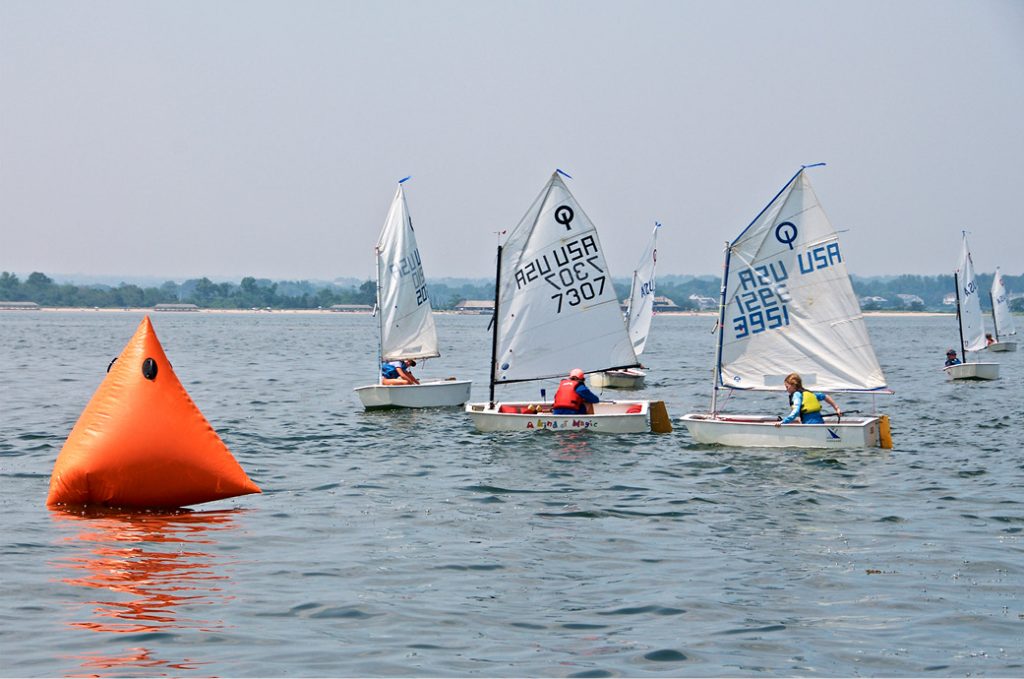One thing you can say for sure about the wind direction is that it’s always changing. Even when it seems like a nice steady day, the wind is constantly wriggling back and forth at least a little bit. And whenever the wind shifts, it creates a large opportunity to gain distance on the other boats in your fleet.
Wind shifts are generally the most significant strategic factor of all. Each time the wind changes direction it re-shuffles the fleet standings, and in almost every race the potential gains and losses due to wind shifts are greater than any other factor, including boatspeed!
For all these reasons, it’s very important to understand what the wind is doing – both before and during your race – and how best to use the wind to your advantage.
Many windward legs are only 10 or 20 minutes long so general, large-scale forecasts (like the ones you get on the web, radio or TV) are not very helpful. It is much, much more important to rely on:
• Local knowledge: In the specific venue where you are racing, what does the wind usually do when it blows from each direction? Use your own experience from past regattas and ask local sailors to tell you what happens.
• Your own observations: These are even more important than ‘local knowledge’ because they apply to your race area on the specific day when you are racing. Be sure to collect these before the start, and keep observing during the race.

Finding the best wind pressure is critical in light air or when there are differences in wind velocity across the windward leg. © Rick Bannerot/OntheFlyPhoto.net
There are many reasons why the wind changes direction. These include the movement of weather systems, thermal heating, changing current, clouds and geographic effects. Keep your head out of the boat and try to understand which of these apply to your particular situation – this will help you know which way the wind will shift next.
Sail toward the next shift! When you expect that the wind will change direction (it happens every beat!), the key idea in your strategic gameplan should be to sail in the direction of the next windshift.
When making a strategic plan for your windward leg, the relative importance of windshifts will depend on several factors:
• In light air, windshifts are less critical; wind pressure and current are more important.
• The importance of windshifts is proportional to their size.
• Shifts are more critical on longer beats where the boats get more separation (farther apart).
Windshifts almost always fall into one of two categories – they are either oscillating (shifting back and forth around a median direction) or persistent (changing steadily in one direction). If you want strategic success, you must constantly ask yourself one simple question during each windward leg: Is the wind direction oscillating or persistent?
The way you answer this question will make a huge difference in how you play the shifts. For example, if you think the wind is oscillating and you get headed you should tack. But if you think the wind is shifting persistently, you should keep sailing into the shift.
Sometimes what appears to be a wind shift is really a change in wind velocity, not in its direction. If you are sailing along and the wind velocity suddenly drops (without changing direction), your apparent wind will shift forward temporarily and it will seem like you’re headed.
Be careful not to treat this “velocity shift” like a real change in direction. If you suspect a change in velocity, wait 30 seconds or so and see if the ‘velocity shift’ disappears once your boatspeed adjusts to the new wind velocity.
Windshifts are different every day. Sometimes it’s very easy to see them on the water; other times it’s impossible. Sometimes when a shift hits your boat it is solid right away; other times you have to sail farther into the shift to make sure it’s real.
When you are trying to make a gameplan to take advantage of the shifts, there is nothing as valuable as sailing around in your race area before the start, just watching (and recording) what the wind is doing. ■



